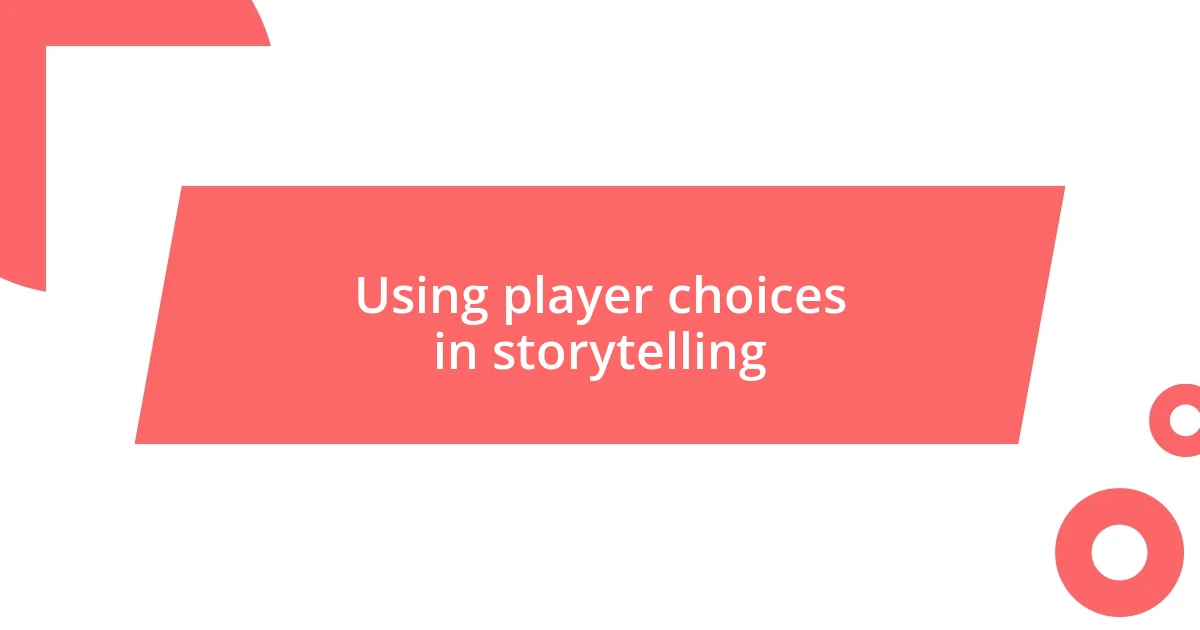Key takeaways:
- Balancing story and gameplay enhances player engagement, with meaningful narratives making gameplay more immersive and memorable.
- Player choices significantly impact the narrative, creating a web of consequences that can lead to emotional connections and reflections beyond the game.
- Integrating character interactions, pacing, and environmental storytelling enriches gameplay by making the narrative more impactful and evocative.

Understanding story and gameplay
Story and gameplay are like two sides of the same coin in game development; they enhance each other when done right. I remember the first time I played a narrative-driven game where the characters’ emotions influenced the gameplay mechanics. It was fascinating to see how the choices I made altered the story’s path while also affecting gameplay. Isn’t it amazing how a gripping narrative can make you more invested in the challenges you face?
In my experience, when gameplay is mechanically engaging, even the simplest story can become compelling. For instance, in a fast-paced action game, I found myself entirely immersed in the narrative during a climactic battle. The thrill of dodging enemies while simultaneously uncovering the protagonist’s backstory created an unforgettable experience. Can you feel the adrenaline rush that comes from intertwining intense gameplay with a meaningful story? It’s a dance between interaction and narrative that keeps players hooked.
Finding the right balance between story and gameplay isn’t just important; it’s essential for player retention. I’ve seen games fail to connect with audiences because they prioritized one over the other. By aligning gameplay mechanics with the story’s emotional beats, developers can create a richer experience that resonates long after the game is over. How do you think story influences your engagement with a game?

Importance of story in games
One of the most profound aspects of storytelling in games is its power to evoke emotions. I remember a moment in a narrative-rich RPG where I was faced with a choice that would determine a beloved character’s fate. When I made that decision, it felt like a weight had settled on my chest. The stakes weren’t just pixels on a screen; they were a reflection of my own values and emotions. This is what elevates a game from mere entertainment to a personal experience.
- Engaging stories deepen player connection to characters and the game world.
- A compelling narrative can motivate players to push through difficult gameplay sections.
- Emotional investment leads to memorable experiences that players will recount long after finishing the game.
- When players understand the backstory, it enhances their strategic approach to gameplay challenges.
- Strong narratives often foster communities around shared experiences and discussions.
When story and gameplay flow seamlessly together, they create a narrative tapestry that envelops players completely. I can recall a time when a game’s plot twist left me stunned, reshaping my approach to every subsequent encounter. That unexpected turn wasn’t just a narrative device; it significantly impacted my gameplay style and created an atmosphere of tension and excitement that lingered until the very end. It’s moments like these that remind me of how influential a well-crafted story can be in a game.

Designing gameplay with narrative
Designing gameplay with narrative is all about creating a harmonious relationship between the two elements. I have often found that when developers weave an engaging story into the gameplay mechanics, it results in a more immersive experience. For instance, I recall playing an adventure game where the protagonist’s backstory was revealed through interactive puzzles. Each challenge revealed a piece of their history, making every success feel meaningful as I slowly pieced together their journey.
When designing gameplay with narrative in mind, it’s crucial to think about how character development influences mechanics. One game I played had a protagonist whose emotional state directly affected their abilities. When feeling strong, they could execute powerful moves, but when overwhelmed by sadness, their combat skills would weaken. This connection created a deeper emotional bond with the character, encouraging me to invest in their growth. How often do you feel that the gameplay mechanics enhance a character’s narrative arc?
Moreover, integrating narrative into gameplay can create a unique feedback loop where players not only engage with the story but impact it through their actions. After a pivotal choice in a story-driven game, I was astounded to discover how dramatically the game’s world shifted based on my decisions. A simple, heartfelt interaction could trigger a cascade of events that altered the entire game landscape. This level of narrative impact made my choices feel significant, inviting a sense of agency that is often missing in traditional storytelling.
| Element | GameplayImpact |
|---|---|
| Character Development | Influences player’s actions and abilities |
| Emotional Stakes | Guides player decisions and enhances immersion |
| Dynamic World Changes | Alters gameplay based on player choices |
| Interactive Puzzles | Dramatically connects story elements to gameplay |

Integrating story elements effectively
One of the most rewarding ways to integrate story elements is through character interactions that bring emotional depth to gameplay. I recall playing a game where I had the opportunity to forge relationships with various NPCs. Every choice I made during conversations had a real impact on how those characters viewed me. This connection made me think twice before deciding, as I genuinely cared about the repercussions. Isn’t it fascinating how a few lines of dialogue can shape our feelings toward a character?
Another integral aspect is the pacing of the story alongside gameplay. I often find that a well-timed narrative reveal can elevate the gameplay experience. In one instance, after completing a particularly challenging level, I was rewarded with a beautifully animated cutscene that unveiled crucial story details. It felt like a reward—not just for my skills, but for my investment in the story. The suspense built during gameplay directly fed into the emotional payoff of the narrative, creating a memorable moment. How can you harness that same sense of pacing in your projects?
Lastly, the environment itself can be a brilliant storyteller. I remember exploring a desolate city in a post-apocalyptic game, where every abandoned building and shattered window whispered fragments of the story. The visual cues led me to construct my own narrative about what had happened there. It sparked my imagination and encouraged me to engage with the environment in a way that felt meaningful. Incorporating environmental storytelling is a powerful tool; it turns the gameplay space into a narrative canvas, enhancing immersion and emotional investment. Wouldn’t you agree that a well-crafted setting can speak volumes more than dialogue alone?

Using player choices in storytelling
Using player choices in storytelling fundamentally transforms how we experience games. I vividly remember a moment in a role-playing game where I had to choose between saving a village or pursuing a revenge quest. My decision didn’t just affect the game’s outcome; it tugged at my moral compass, forcing me to weigh my values against what I wanted for my character. How often do we find ourselves reflecting on our choices long after the game is over?
It’s fascinating how player agency can lead to unexpected narrative outcomes. In one game, a seemingly minor choice I made early on snowballed into a significant relationship shift later in the story. This twist made me realize that every action counts, creating an intricate web of consequences that kept me thoroughly engaged. Isn’t that what makes gaming so compelling? The journey is unpredictable, and that uncertainty keeps us coming back for more.
I also appreciate how player choices can evoke real emotional responses. In a narrative-based game, I faced a heart-wrenching moment where I had to betray a loyal companion to secure my survival. It was gut-wrenching, and even after completing the game, I grappled with that choice and its impact on my character’s humanity. That kind of storytelling isn’t just about progress; it stays with you, enriching your experience in ways you never see coming. How can we create those deeply emotional moments in our games to resonate with players long after they’ve set the controller down?















